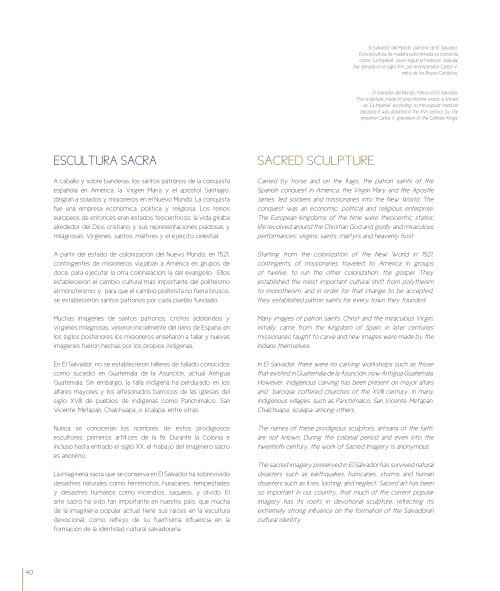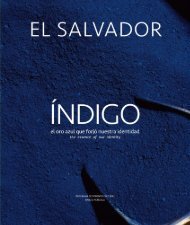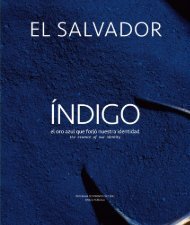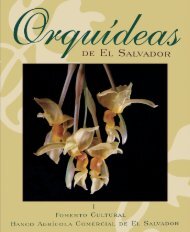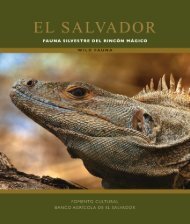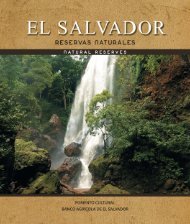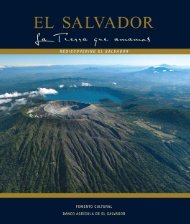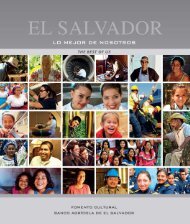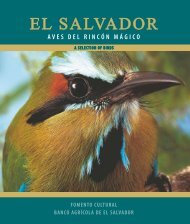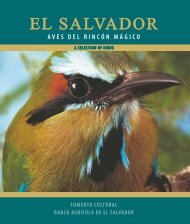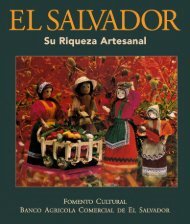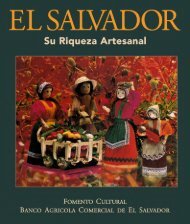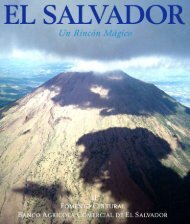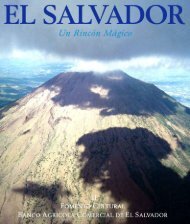Monumentos y Esculturas
You also want an ePaper? Increase the reach of your titles
YUMPU automatically turns print PDFs into web optimized ePapers that Google loves.
El Salvador del Mundo, patrono de El Salvador.<br />
Esta escultura de madera policromada es conocida<br />
como “La Imperial”, pues según la tradición popular<br />
fue donada en el siglo XVI, por el emperador Carlos V,<br />
nieto de los Reyes Católicos.<br />
El Salvador del Mundo, Patron of El Salvador.<br />
This sculpture; made of polychrome wood, is known<br />
as “La Imperial” according to the popular tradition<br />
because it was donated in the XVI century, by the<br />
emperor Carlos V, grandson of the Catholic Kings.<br />
ESCULTURA SACRA<br />
A caballo y sobre banderas, los santos patronos de la conquista<br />
española en América, la Virgen María y el apóstol Santiago,<br />
dirigían a solados y misioneros en el Nuevo Mundo. La conquista<br />
fue una empresa económica, política y religiosa. Los reinos<br />
europeos de entonces eran estados teocéntricos: la vida giraba<br />
alrededor del Dios cristiano y sus representaciones piadosas y<br />
milagrosas: Vírgenes, santos, mártires y el ejército celestial.<br />
A partir del estado de colonización del Nuevo Mundo, en 1521,<br />
contingentes de misioneros viajaban a América en grupos de<br />
doce, para ejecutar la otra colonización: la del evangelio. Ellos<br />
establecieron el cambio cultural más importante del politeísmo<br />
al monoteísmo; y para que el cambio politeísta no fuera brusco,<br />
se establecieron santos patronos por cada pueblo fundado.<br />
Muchas imágenes de santos patronos, cristos adoloridos y<br />
vírgenes milagrosas, vinieron inicialmente del reino de España; en<br />
los siglos posteriores los misioneros enseñaron a tallar y nuevas<br />
imágenes fueron hechas por los propios indígenas.<br />
En El Salvador, no se establecieron talleres de tallado conocidos<br />
como sucedió en Guatemala de la Asunción, actual Antigua<br />
Guatemala. Sin embargo, la talla indígena ha perdurado en los<br />
altares mayores y los artesonados barrocos de las iglesias del<br />
siglo XVIII de pueblos de indigenas como Panchimalco, San<br />
Vicente, Metapán, Chalchuapa, o Jicalapa, entre otras.<br />
Nunca se conoceran los nombres de estos prodigiosos<br />
escultores, primeros artífices de la fe. Durante la Colonia e<br />
incluso hasta entrado el siglo XX, el trabajo del imaginero sacro<br />
es anónimo.<br />
La imaginería sacra que se conserva en El Salvador ha sobrevivido<br />
desastres naturales como terremotos, huracanes, tempestades<br />
y desastres humanos como incendios, saqueos, y olvido. El<br />
arte sacro ha sido tan importante en nuestro país, que mucha<br />
de la imaginería popular actual tiene sus raíces en la escultura<br />
devocional, como reflejo de su fuertísima influencia en la<br />
formación de la identidad cultural salvadoreña.<br />
SACRED SCULPTURE<br />
Carried by horse and on the flags, the patron saints of the<br />
Spanish conquest in America, the Virgin Mary and the Apostle<br />
James, led soldiers and missionaries into the New World. The<br />
conquest was an economic, political and religious enterprise.<br />
The European kingdoms of the time were theocentric states:<br />
life revolved around the Christian God and godly and miraculous<br />
performances: virgins, saints, martyrs and heavenly host.<br />
Starting from the colonization of the New World in 1521,<br />
contingents of missionaries traveled to America in groups<br />
of twelve, to run the other colonization: the gospel. They<br />
established the most important cultural shift from polytheism<br />
to monotheism, and in order for that change to be accepted,<br />
they established patron saints for every town they founded.<br />
Many images of patron saints, Christ and the miraculous Virgin,<br />
initially came from the kingdom of Spain; in later centuries<br />
missionaries taught to carve and new images were made by the<br />
Indians themselves.<br />
In El Salvador, there were no carving workshops such as those<br />
that existed in Guatemala de la Asunción, now Antigua Guatemala.<br />
However, indigenous carving has been present on major altars<br />
and baroque coffered churches of the XVIII century, in many<br />
indigenous villages, such as Panchimalco, San Vicente, Metapán,<br />
Chalchuapa, Jicalapa, among others.<br />
The names of these prodigious sculptors, artisans of the faith,<br />
are not known. During the colonial period and even into the<br />
twentieth century, the work of Sacred Imagery is anonymous.<br />
The sacred imagery preserved in El Salvador has survived natural<br />
disasters such as earthquakes, hurricanes, storms and human<br />
disasters such as fires, looting, and neglect. Sacred art has been<br />
so important in our country, that much of the current popular<br />
imagery has its roots in devotional sculpture, reflecting its<br />
extremely strong influence on the formation of the Salvadoran<br />
cultural identity.<br />
40 41


